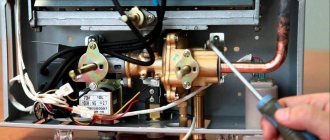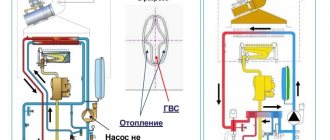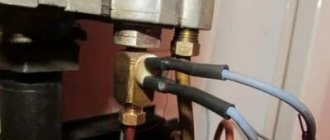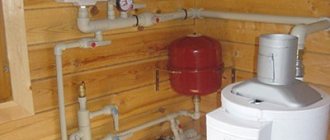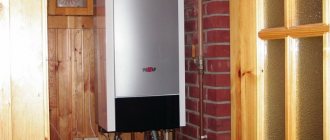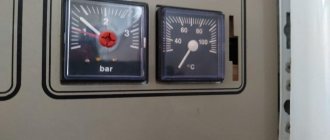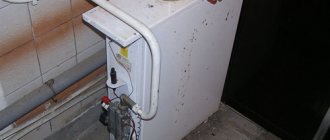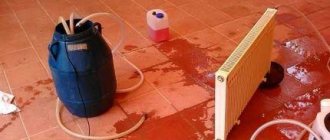The boiler is smoking. Black smoke is coming from the chimney. Soot settles in the boiler, in the pipe, and flies out of the pipe. Why might the boiler smoke? (10+)
Why does the boiler smoke?
The material is an explanation and addition to the article:
Heating with coal. Practical experience. Coal heating experience. Warm, comfortable, but troublesome. Comfort and safety of coal heating.
The boiler is smoking. Black smoke is coming from the chimney. Soot settles in the boiler, in the pipe, and flies out of the pipe. Why might the boiler smoke?
Here is a selection of materials:
Everything you need to know about heating and climate control Features of the selection and maintenance of boilers and burners. Comparison of fuels (gas, diesel, oil, coal, wood, electricity). Do-it-yourself ovens. Coolant, radiators, pipes, heated floors, circulation pumps. Chimney cleaning. Conditioning
A boiler can smoke for several reasons. Insufficient air flow, excessive air flow, poor fuel quality, insufficient fuel pressure, clogged nozzles, impaired air flow turbulation in the burner, insufficient boiler temperature.
Insufficient air flow may be due to wind if the ventilation hole for air flow into the room with the boiler is made on the wrong side of the house from the chimney pipe. Then wind currents can create pressure differences that prevent air from entering the combustion chamber of the boiler. If there is insufficient air flow, the fuel does not burn completely and soot forms. A sign of lack of air is the dark purple color of the flame. Provide fresh air flow into the boiler room from the desired side of the house. Insufficient air flow, and, consequently, soot, can occur due to clogging of the chimney or the boiler itself.
Excessive air flow occurs when there is excess draft if a draft regulator is not installed. Excessive draft can occur at very low outside temperatures. When there is excess draft, the flame is white. Due to excess air flow, the temperature of the exhaust gases becomes insufficient for complete combustion of the fuel.
Insufficient or excessive air flows can occur due to improper adjustment of the boiler burner, primary, secondary and tertiary air flows in a solid fuel boiler.
Poor quality of fuel, presence of moisture, foreign impurities, etc. Foreign impurities, when burned, themselves form soot and disrupt the normal combustion process of the fuel.
Insufficient fuel pressure. This primarily applies to gas. In severe frosts, gas consumption increases. There is a decrease in pressure in the line. Low pressure in the line is immediately noticeable by a short flame, which sometimes breaks, and by a drop in boiler power. Insufficient diesel fuel pressure can be caused by a clogged filter or freezing (waxing) of diesel fuel.
Clogged injectors. Boiler nozzles require regular cleaning and periodic replacement. If this procedure is not carried out at the required frequency, the boiler may become smokey.
Violation of turbulation. In boilers, the flow of heated gases is specially swirled to ensure complete combustion of the fuel. If the swirl is incorrect and does not correspond to the calculated values, then the fuel does not burn completely and soot appears.
Insufficient boiler temperature. Many boilers have restrictions on the temperature of the coolant in the boiler. Many boilers function normally only at a coolant temperature of 80 degrees Celsius. Otherwise, the gases enter the chimney too cold, which leads to decreased draft and smoking.
Unfortunately, errors are periodically found in articles; they are corrected, articles are supplemented, developed, and new ones are prepared. Subscribe to the news to stay informed.
If something is unclear, be sure to ask! Ask a Question. Discussion of the article.
How to install and configure a gas heating burner. How to properly install, connect and adjust a gas heating burner.
Pipe heating system to prevent winter water supply from freezing. With your own hand. DIY plumbing. External, non-freezing. Laying water pipes h.
Why does the boiler smoke? A coal boiler has been installed. Lately it has started smoking. What could it be?
Flame, combustion, fire, torch. Theory. It smokes, it smokes, it goes out. Incomplete. Why does the flame smoke or go out? Incomplete combustion - causes. What does quality depend on?
Heating gas burners. How to choose? Personal experience, review. How to choose the right gas burner for heating. Adviсe. Personal experience. Review.
Here we will tell you why a gas boiler may become clogged and indicate one of the possible solutions to this problem.
What you will read below concerns gas boilers of old brands, such as AGV, AOGV. Although, probably, new boilers are sometimes subject to clogging with soot . It happens. The boiler has been running for some time. Sometimes it “for some reason” gets clogged. What is the reason? If you call a gas technician, he will, of course, disassemble the boiler, clean it, fill out his protocol (well, or whatever else he has), and offer to sign it. After which you will have to pay the cost of the work carried out to clean soot from your boiler. Yes, formally everything is correct here. However, it is unlikely that the gas worker will tell you the reason for the blockage (unless, of course, he has the highest qualifications. But such people do not go around apartments, but work in higher positions). And most likely, an ordinary gas equipment mechanic will come to you and will be able to unscrew it, tighten it, clean it, and lubricate it completely. Yes, he will also be able (and will not accept this) to tell you that it is time to replace your boiler with a new one. It’s like his time has run out. Moreover, the older your boiler is, the more annoyingly the technicians will try to persuade you to buy a new one. Of course, this is a personal matter.
The fact is that. Over time, the boiler may become clogged with soot again. This time can take from one week to several years. The latter can be considered a fortunate coincidence. But what if the boiler becomes clogged with soot more often than you have time to think about it?
You can, of course, change boilers (costing about 20.50 thousand rubles) at least every year, or even every month. This is provided that
- You have money... well, you just don’t even know approximately where to put it. Well, in fact, you can’t use them to heat the stove instead of gas fuel.
- Are you tired of not only friends, work, entertainment, the Internet? but also almost absolutely everything in this life.
- Do you like it if there are periodic repairs at home, a mess, traces of soot everywhere.
- You love to watch how gas workers work, give you advice, the working environment in the house, etc.
Advantages and disadvantages
pros
- Ease of installation. The binding is simple. Installation manipulations involve connecting the circuit pipes (supply and return) to the boiler. Plus – the presence of a chimney. In some cases, there is a need to connect to the power line.
- Economical. The simplest calculations confirm that solid fuel boilers are more profitable than a number of analogues (diesel, electric). For rural areas and regions with developed woodworking and coal mining industries, installations of this type are the best choice. The price of fuel is minimal, and there are no problems with purchasing.
- Energy independence. But this only applies to the boiler. When heating large areas, a gravity system is ineffective, so a pump is included in the circuit. Its performance depends on the presence of electricity.
- Versatility. With the right choice of solid fuel installation, you can easily switch from one type of “fuel” to another. In addition, the concept of a “wood-burning” boiler is interpreted more broadly. Its firebox burns any organic matter perfectly: branches, sawdust, “eurowood” and other similar materials. At the same time, the issue of disposal of construction and household waste is being resolved.
- The probability of failure is low. Simple design - there is practically nothing to break.
- Acceptable price of equipment. Most solid fuel boilers are budget models.
Minuses
- Installation restrictions. Only in a separate room. But the requirements for it according to GOST and SNiP are more flexible than for gas equipment. This is a definite plus.
- Fuel storage. In the private sector, the problem is easily solved. If pellets are used for a solid fuel boiler, it is even more convenient. They are sold in plastic packaging and can be stored in any utility room.
- Periodic loading of the firebox. The downside is relative - some types of installations can be avoided for many hours.
- Efficiency is lower than that of other types of equipment. But there are nuances here. Pyrolysis boilers, according to this indicator, are practically not inferior to electric and gas installations.
- Operation is accompanied by dirt and dust. How much of a disadvantage is this if the solid fuel unit is mounted in a separate room? And the neatness of the owners is an important factor.
Features of a double-circuit solid fuel boiler
Long-burning solid fuel boilers with two heating circuits for heating and hot water supply are the best option for heating a private home.
A heavy-duty double-circuit boiler for heating a private home, capable of generating a sufficient amount of heat, is considered very economical and easy to maintain. The combustion process in such modifications of solid fuel boilers requires minimal participation of maintenance personnel.
Design
Double-circuit boilers with a long combustion process have a standard design typical of many solid fuel models, with the exception of an additional heat exchanger for heating hot water. Basic equipment of solid fuel boilers with 2 heating circuits:
- boiler body with thermal insulation;
- combustion chamber for fuel combustion;
- ash pan for collecting and removing ash;
- capacitive heat exchanger of the heating system;
- coil type heat exchanger for hot water supply;
- safety automation unit with primary control sensors;
- air and draft regulators;
- blower fan, for systems with forced circulation of flue gases;
- centrifugal circulation pump, for systems with forced circulation of coolant.
Advantages
A double-circuit solid fuel boiler is today the most promising unit that is most capable of satisfying all user requests. Among the main advantages of the model:
- Availability for any region, relatively low prices for purchase and installation, high payback period due to the low cost of generating a unit of thermal energy.
- Duration of the combustion process. Modern modifications of boilers with mechanical fuel supply ensure uninterrupted operation of boilers without human intervention for up to three days.
- The service life is more than 10-15 years.
Flaws
There are no perfect heating units in the world; they all have their drawbacks, just like a double-circuit solid fuel boiler.
Its main disadvantages include:
- Manual loading of fuel into the boiler.
- Great inertia, due to which the boiler has a low level of automatic control and safety. The boiler cannot be completely turned off until all the fuel has burned out.
- Lack of automatic temperature control of heated water.
- The need to arrange a dry place for storing fuel.
- The need to dry the fuel before loading it into the boiler.
As is obvious, the disadvantages of this modification of the boiler are not so significant; they are much fewer than the positive qualities.
Problems with a solid fuel boiler
Sometimes the heating device smokes due to the banal filling of the ash pan. Before looking for another possible source of problems, you should empty the ashpit and check the condition of the grate. The second most common problem with a solid fuel boiler is a clogged chimney. The reason is poor quality fuel. When using damp firewood or wood with a high resin content, not only soot is formed, which easily crumbles after tapping on the chimney casing. Resinous soot with a high moisture content adheres firmly to the walls, after which it hardens and narrows the diameter of the pipe.
Read also: Pripyat, a ghost town
ATTENTION! If damp firewood is used and the smoker is not properly insulated, this leads to the formation of condensation. In combination with soot, it turns into a caustic substance that can damage the chimney. When the pipe is corroded, traction is disrupted.
Why does soot form in the chimney?
When fuel burns, it releases products that are carried away by the flow of furnace gases. Sometimes they do not evaporate completely, settling on the walls, clogging the passage.
The reason may be:
- Burning damp wood. Due to increased humidity, active evaporation occurs. The vapor moves through the chimney and mixes with the cooled air flows. As a result, condensation settles on the walls. Due to the acid content in the vapor, carbon deposits form. It can be difficult to get rid of it.
- Use of unsuitable fuel. Waste consisting of wood and binding fillers, such as plywood, is not suitable for combustion. They release a lot of resins, which settle in large quantities on the walls of the chimney.
- Use for burning household waste. Such fuel always contains polyethylene or plastic packaging. When burned, garbage releases many harmful chemicals that quickly clog the chimney.
- The chimney is cold. It was noted that a certain temperature can trigger the formation of condensation. As a result, a layer of soot appears on the walls inside the structure.
- Horizontal pipe sections. A large amount of soot is formed in the bends of the structure. Therefore, when installing the pipe, the horizontal installation method should be avoided. But if there is no other way out, cleanouts are installed in the fold areas. They will allow you to open the knee and remove soot.
- Roughness of wall surfaces. If the channel was not mopped when laying the structure, this will cause unevenness in the chimney, where soot will clog.
The first three points apply only to wood-burning stove heating.
If the gas boiler smokes
In addition to errors associated with improper installation of equipment, the quality of the fuel plays an important role in the operation of the unit. This issue is especially relevant when using liquefied gas from a cylinder.
After the combustion of clean fuel, a small amount of dry soot remains. Flakes of this substance accumulated in the pipe can be easily eliminated. It is enough to tap the chimney from the outside and remove the crumbling soot through the technical window.
Read also: Nail fungus on toes and hands
After the combustion of gas with a large number of impurities, greasy soot adheres to the walls of the chimney, gradually narrowing the lumen. This substance is quite difficult to clean off. A regular pipe brush may be useless. In such a situation, it would be best to disassemble the smoker and clean its components separately.
Quite often, a gas boiler smokes due to improper adjustment of the flame intensity. If the user, in violation of all instructions, turns on the burner of a cold boiler at full power, then the appearance of smoke will be a natural result. The problem can be avoided by gradually increasing the combustion temperature after kindling.
Subtleties of cleaning a stainless steel chimney
Stainless steel structures have a good internal surface quality. The characteristics of the chimney allow the condensate to drain into a special collection tank. It is necessary to periodically empty it and dispose of the liquid. This helps prevent soot from appearing. But this does not prevent stainless steel models from developing carbon deposits.
Blockage in the chimney
If you find it, it is recommended to remove it. For this:
- You will need a brush on a flexible round shaft. It must be placed in the pipe through the hole in the tee. The tool must be rotated using an electric drill. You must act carefully. As you move forward, the drive shaft must increase in length. This will allow you to completely clean the entire pipe.
- If the soot has formed quite stable, it is recommended to use burning. To do this, use a blowtorch. The chimney is first dismantled. Then burning is used. It is enough to set the temperature to 800-900 degrees.
It is recommended to check the quality of the stainless steel construction before starting cleaning. It is important to correctly define the class. This affects the ability to use different cleaning methods. High-quality stainless steel will not be magnetic. This can be cleaned using the specified means and not worry about its safety.
If sandwich pipes are used, there is rarely a need to clean them. This is due to a working condensate removal system. But if the need arises, then the tool you should use is a long cylinder-shaped brush equipped with a flexible drive cable. It should rotate using an electric motor, which will allow the structure to be thoroughly cleaned.
Another suitable cleaning option is to dismantle the chimney. Then it is enough to process each part separately.
How to clean a burner with nozzles
The burner is the most important part; it must be perfectly clean, otherwise there will be no fuel savings. This applies to any type of boiler: wall-mounted or floor-mounted.
- the gas supply must be shut off;
- the burner is removed from the boiler;
- unscrew the nozzle (it’s convenient to take a photo before doing this so you know how to put the nozzle back);
- The nozzle is carefully cleaned with a soft brush;
- The burner is cleaned with a brush;
- The burner holes are purged with any pump (regular bicycle or car);
- the nozzle is inserted back into the burner (do not confuse its location);
- The burner and nozzle are put in place.
Troubleshooting solid fuel models
Solid fuel boilers may have the same causes of smoke associated with the chimney as gas appliances described above. When burning, it is necessary to use well-dried raw materials. It should be stored in well-suited places with low humidity. Do not use synthetic materials as fuel.
Wood-burning boilers such as Buderus Logano SW, Stropuva S and Zhitomir D should be heated only with dry wood. To be able to use different types of fuel, you need to purchase combined devices such as KST or Dymok. You can experiment with the degree of opening of the gate in air-heating models, such as. If smoke appears, make the chimney opening larger.
Ensure air flow into the boiler room. For safety reasons, the window must be open constantly while the boiler is operating during the heating season. The device operating on solid fuel must be cleaned regularly. This is especially true if it is coal or diesel, running on exhaust, since these types of fuel clog the burner especially quickly.
Causes of boiler smoking
Some signs help determine what to look for first when smoke and soot appear in the room. Conventionally, the causes of smoke can be divided into 4 groups:
- A clogged chimney pipe is one of the most common problems. This could be either a foreign object that has entered from outside, or the result of using low-quality fuel.
- The discrepancy between the chimney and the boiler power or the height of the building is less common and is detected almost immediately, during the first fires. In a situation where at first everything was fine, and then it began to smoke, this reason should not be considered.
- Damage to the chimney is the least likely case. But if the boiler is smoking at the beginning of a new heating season, then inspecting the pipe should be one of the first tasks.
- Weather conditions affect natural draft in only two cases: low chimney height and incorrect location of the fresh air inflow point.
ATTENTION! A problem that occurs immediately after installing the equipment indicates errors made during the installation process.
The smoker must be raised above the roof ridge. The diameter of the pipe is selected in strict accordance with the power of the boiler: a small cross-section simply cannot cope with the removal of smoke from a serious firebox. You should also avoid right angles in places where the pipe changes direction - this impedes air circulation, which does not have the best effect on traction. A visual inspection allows you to identify these shortcomings and eliminate them.
Classification of faults
All problems with gas boilers can be divided into categories:
Read also: The child does not hold his head well
- Primary or secondary. Primary ones are evidence of indicating problems in the operation of one or even several nodes. If the fault has not been repaired, a secondary fault appears. It is the result of ignoring the problem. After a secondary problem occurs, the equipment stops working.
- Hidden or obvious. The first group includes leaks in heat exchangers or butt joints, breakdowns in hot water supply or heating circuits, as well as other malfunctions that a person cannot detect without appropriate training.
- Gradual or sudden. Some damage develops unnoticed due to changes in the operating parameters of units or changing conditions, while others are unpredictable and suddenly appear at the least opportune moment.
- Final damage. Sometimes the cause of an accident can be immediately identified. For example, after a fall, the unit immediately stops working. Then the cause is mechanical damage.
What to do if the boiler is smoking
Regardless of why the smoke began to appear, it is necessary to stop the kindling and conduct a visual inspection of the equipment for damage.
IMPORTANT! Particular attention should be paid to the traction stabilizer if it is built into the exhaust gas exhaust system. Sometimes it is enough to adjust the confuser or check the condition of the interrupt valve to get rid of problems for a long time.
Smoke immediately after installation of the equipment indicates errors made during installation. In this case, it is necessary to double-check all components and connections to ensure the integrity of the chimney and its correct installation.
At the beginning of the heating season, smoke in the boiler room indicates clogging or damage to the exhaust gas removal system. Usually, after eliminating the problems, traction is restored.
If a gas boiler smokes when starting up, and then everything gets better, then it makes sense to check the burner. When clogged, it not only produces soot, but also reduces the performance of the unit. In a solid fuel boiler, the cause of the “starting” smoke is often the low quality of the firewood.
Do I need to clean the chimney with gas heating?
The chimney of a gas boiler, regardless of its design and material of manufacture, must be cleaned regularly. Soot constantly settles on the walls of the structure, which causes narrowing of passages and smoke entering the room. This not only causes the equipment to malfunction, but also threatens the health of the inhabitants of the house. The more often you clean, the simpler and easier the next process will be.
We recommend reading: Why regular inspection of gas equipment is necessary
When soot constantly forms in a gas boiler, this can lead to the following problems:
- Reduced thermal conductivity.
- The heating equipment will begin to warm up unevenly. This will cause the weld seams to break.
- Sensors will receive incorrect data, which will lead to reduced equipment performance.
For correct and long-term operation of the gas boiler, it is recommended to regularly clean the chimney.
The main reasons why AOGV gas boilers smoke
There are usually two reasons why AOGV gas boilers smoke:
- low gas quality;
- chimney problems.
You should check the presence of draft in the chimney using a lit match brought to the entrance to the channel: if the fire is deflected, then draft is present; If the flame burns evenly, then there is no draft. If there is no draft, check the chimney to see if it is clogged, if there are cracks in the pipe or ice crust on the tip.
Signs of a clogged chimney
When the flue gas exhaust channel becomes clogged, it will be immediately visible. The main signs of a clogged channel will be the following:
- Deterioration of draft in the stove or fireplace. You need to check the gate, and if it is in the open position, it means that the pipe is overdue for cleaning.
- Gradual attenuation of the flame in the furnace of a heating unit.
- Difficult fuel combustion. If you use dry wood and it doesn't burn, the chimney is most likely to blame.
- Changing the color of the flame in the firebox. You should be especially wary if it has acquired an orange color.
- Strong unpleasant odor. If acrid smoke appears in the room during the combustion process, it means that carbon monoxide (carbon monoxide) is entering it. In this case, the room should be well ventilated, the firebox should be interrupted and measures should be taken to clean the chimney.
The appearance of smoke when the gate is open indicates a lack of draft
What to do if the chimney is clogged
Before the start of the heating season, you must inspect the inside of the chimney for blockages. In the warm season, birds with a nest may settle in it, or debris may appear, blown into the pipe by the wind. To avoid this, the chimney must be equipped at the installation stage with a cap with a mesh that prevents such situations.
In such a case, the house should always have a backup heating unit in the form of a heater or an electric heater built into the heating system.
Having provided yourself with warmth with its help during the cold season, you can carefully consider the situation and think through options for getting out of it.
The presence of draft in the firebox must be checked every time the stove is ignited - the flame must deviate towards the chimney
When is cleaning possible?
In any case, it is inappropriate to wait until the moment when the device turns into a grimy “Cinderella”, so cleaning the gas boiler from soot is carried out at a certain time. There are three options.
- Periodic maintenance. It is a necessity. Owners are recommended to perform preventative cleaning of equipment at least once every 2 years. Better - once a year.
- Such a “cleaning” operation is required when the efficiency of a gas boiler decreases: heating of water for hot water supply is worse, heating does not work well enough. Usually in such circumstances a professional is called.
- Cleaning a gas boiler from soot during repair work. When a heat generator breaks down during the heating season, the technician who comes to fix it also does preventive maintenance - cleans the heat exchanger.
The first 2 cases are not very attractive for equipment owners, since they involve expenses due to the invitation of an “alien” master. Often you can handle cleaning yourself, but almost any rule has exceptions. For example, it is better not to experiment with a condensing boiler that has a closed combustion chamber. If the owner is completely unfamiliar with such a unit, then professional help is already a necessity.
Preventative cleaning of a gas boiler from soot - flushing the heat exchanger - is a simple operation, and it is also performed quite quickly. This procedure can be carried out independently without much difficulty.
There are certain symptoms that indicate the need to clean your equipment. These include:
- increased gas consumption due to clogged heat exchanger;
- an atypical hum inside the device due to pump overload;
- reducing water pressure in the DHW circuit;
- radiators that are not hot enough;
- constantly working burner.
All these signs may not only be symptoms of a clogged unit, so other possible causes of problems should also be taken into account when diagnosing the equipment yourself.
How to understand that there is a need for chimney cleaning
There are signs by which you can determine that your chimney needs cleaning. This will allow you not to miss the moment and not aggravate the contamination situation to the point where the equipment fails.
Important to remember!
Martyanov Pavel
Specialist in the field of gas equipment maintenance, 20 years of experience
Ask a Question
Timely maintenance of chimney systems is not only a guarantee of stable operation of gas equipment, but also a guarantee of your safety. Exhaust gases are extremely dangerous to human life and health.
The burner does not turn off and constantly works
When the heat exchanger becomes clogged, the water begins to heat up more slowly. The turbine continues to pump new fluid. The burner is in constant operation, trying to achieve the desired temperature value for the water.
Read a detailed article on this topic: Why does the gas boiler not turn off and constantly work?
The pressure in the hot water supply circuit has dropped
This happens as a result of improper operation of the heat exchanger or leaks in the pipeline system. Depressurization of the fluid supply circuit could also occur.
We recommend reading: Why the pressure in the heating system drops, reasons and solutions
Rumble and extraneous sounds in the operation of the circular pump
Blockages prevent water from circulating normally. Therefore, the pump is overloaded during operation. This is indicated by equipment malfunctions, extraneous noise, or engine overheating.
Also read with this article: The main reasons why a gas boiler hums
Gas consumption has increased
The formation of blockages is one of the reasons why gas consumption increases. This is due to the need for more fuel for the boiler. When cleaning is carried out and scale is removed, gas consumption returns to normal.
List of reasons why the flame inside the boiler may go out
The flame of the gas burner goes out - this is a sure sign of a malfunction of the heating element or a violation of the rules of its operation. In any case, it is necessary to diagnose the device and identify the underlying cause. A gas boiler repair specialist can handle this. It can be found at any service center. Or they call a gas service employee if the reason does not lie in the heating unit.
The boiler is the reason
A gas boiler may go out due to a malfunction of the electronic system.
Most modern boilers are controlled by an electronic system. She controls the automation. The latter takes care of the safe operation of boilers. As soon as one of the sensors fails or sends an incorrect signal, the automatic system immediately stops the operation of the unit. The result is that the flame of the gas burner goes out. This is a typical problem with heating appliances. In this case, their electronic parts are checked.
In addition, there are a number of factors that affect the operation of a gas burner:
- the flame does not light up or is weak - the nozzles are clogged. They are cleaned with a soft brush. It is possible that air may enter the gas line;
- the unit does not turn on either in manual mode or when it is started automatically - the filter through which air is supplied may become clogged or the ignition electrode may be damaged. You can configure their operation yourself;
- The gas boiler goes out after a short period of operation - the operation of the ionizing electrode has been disrupted. You cannot repair it yourself;
- the fire breaks away from the igniter - this is the result of excessive air flow through the ventilation;
- the flame in the boiler goes out, and the unit makes a lot of noise - these are signs of malfunctions in the built-in circulation pump or fan.
In addition, the device may not perform its functions well if potential arises on its body. The solution to the problem is to organize grounding. The electronic part of the unit can also stop its operation if it fails. In this situation, they resort to replacing the electronic board.
External factors affecting the operation of a gas burner
The boiler can also go out due to poor gas quality.
The flame in the boiler can go out not only due to a malfunction of the unit itself. Its functioning can also be influenced by external factors. So, very often a gas boiler goes out due to excess pressure in the oxygen supply system or strong wind outside.
If the fire does not flare up due to strong winds outside, experts recommend installing various caps on the top of the chimney. This compensates for the rarefied atmosphere at the outlet of the pipe, thereby preventing the fire from going out.
In the second case, you just need to adjust the mechanism of the supply and exhaust ventilation and everything will return to normal.
One of the typical cases is, on the contrary, insufficient pressure (draft) in the pipe. This happens if the chimney height is small. In this case, the pipe is simply extended. The second option is ice on the chimney. Frozen water interferes with air circulation. Oxygen deficiency occurs and the fire goes out. The solution to the problem is to remove the chimney cap and defrost it at room temperature. You must not knock off the ice, as this operation may damage the mechanical integrity of the device.
Gas main and problems with it
Very often a gas boiler goes out when it is supplied with low quality gas with a high oxygen content. There's nothing you can do about it, you just have to wait for it to end. The device may receive a small amount of fuel if the gas meter is faulty. It can cut off the supply of energy. A typical problem is the malfunction of gas leakage and temperature control sensors, which are installed at the inlet of the device. One failure - the boiler goes out.
But in any case, regardless of the nature of the breakdown. Everything can be fixed, and replacement of the unit is resorted to only as a last resort.
Boiler draft regulator
With the help of a draft regulator, solid fuel boilers can themselves maintain the temperature you ; all that remains is to load them with new portions of fuel. The regulator consists of a control thermostat which is connected by a chain to the lower damper door. The wider the lower door is open, the more combustion air enters the firebox. It works like this: You set the desired temperature on the thermostat, as the boiler cools, the lever rises and, through a chain, opens the damper. The air flow increases and the flame in the boiler flares up stronger. The mechanical traction control has low accuracy and risks of parts getting stuck. If, as a result of operation, it turns out that primitive adjustments are not enough, then you can install an electronic regulator that opens the damper and changes the speed of the circulation pump.
Lack of air for gas combustion
Problem related to lack of traction. Even if the boiler and chimney are in order, the lack of fresh air entering the combustion chamber of the burner can lead to the flame extinguishing.
From our school physics course we know that combustion requires oxygen. The powerful flame of the burner quickly burns it out of the air, turning it into carbon dioxide. If very little new air enters, the combustion stops, the flame subsides, and the automation turns off the gas supply.
Why does soot appear?
During its operation, a gas boiler burns a large amount of natural gas, which is impossible without oxygen. To burn one cubic meter of gas, you need 10 cubic meters of air, and if there is not enough air, the gas simply will not burn completely, forming a huge amount of soot in the process. This can only be prevented by ensuring sufficient air supply.
Before adjusting the air flow, you need to pay attention to the flame. In order not to look inside the boiler, risking your eyesight, you should use a mirror:
Unstable operation of the electrical network
We have already said that the answer to the question of why a gas boiler goes out can also be interruptions in the power supply network. The absence of a voltage stabilizer can negatively affect the following elements of the heating device:
p, blockquote 23,0,0,0,0 —>
- Pump. If the circulation pump stops working, the burner will go out and the unit will make noise. In this case, repair or complete replacement of the boiler is required.
- Igniter. Take a closer look at the flame. If you observe an intermittent supply of fire, then the pressure on the igniter is incorrectly selected and should be adjusted.
- Burner. If it becomes clogged, you need to clean the nozzles and filter. You can do this yourself using a small brush or wire of the appropriate size.
- The traction sensor may fail if the contacts oxidize. Clean.
- Thermocouple. In case of burnout, the signal from the thermocouple will not be received, and the protection valve will shut off the gas supply. The solution is to clean or replace the thermocouple.
How to clean interior surfaces
Washing the inner surface of a plate, fire tube or bithermal heat exchanger is possible only with the help of special equipment.
- High pressure pump – hydrodynamic flushing. Used to remove small deposits. Advantages are the speed of the procedure and the ability to clean without removing the heat exchanger.
- Booster (acid-resistant pump) – acid (chemical) flushing. Removes even old scale. Advantages – removes scale that cannot be removed by other methods. Disadvantages - if the reagents (acids and neutralizers) are selected incorrectly, it reduces the service life of the heat exchanger.
- Complex "Streamer" for electric discharge cleaning. Used to remove scale of any strength. Advantages - the metal of the heat exchanger is not destroyed, a high degree of cleaning is ensured. Disadvantages: noise and duration of the procedure.
Of all the methods listed above, only chemical cleaning is possible at home, since the factory booster can be replaced with a low-pressure pump. The rest of the equipment is both expensive and voluminous, so such boiler washing can only be carried out by service centers.
If smoke comes into the room from a gas boiler
A wall-mounted or floor-standing boiler and AOGV can smoke for two main reasons: a malfunction of the chimney or poor gas quality.
First of all, it is necessary to inspect the chimney and carry out the following work:
The presence of traction is checked. This can be done either with a special measuring device, or by holding a lit match. The flame should deviate noticeably towards the boiler. If this does not happen, it means that the chimney for some reason does not pull smoke out.
View the pipe using a mirror and a flashlight. If necessary, remove snow and foreign objects. If you cannot do this yourself, call a chimney sweep. If you heat with damp wood, you need to clean out the accumulated tar from time to time. Replace the chimney with a suitable type and diameter for this model. For example, the Lemax Premium device requires a chimney with a diameter of 200 mm. Increase the length of the pipe; in your house, its end should end above the ridge of the roof. Insulate the outside with glass wool. Inspect the chimney for cracks
Pay special attention to connecting seams. Remove right angles when turning and make transitions smooth.
In the room where the gas boiler is located, a window must be open to allow air to enter. This is especially true during the cold season in high-rise buildings, where a layer of cold air may prevent combustion products from escaping.
If you heat with a gas boiler and use cylinders rather than a centralized gas pipeline, it is important to purchase high-quality liquefied gas from trusted manufacturers. The Ross Lux model allows you to do this.
External factors: problems with the chimney
The wick in the burner of a gas boiler can go out not only from a malfunction within the system, but also as a result of external factors.
Icing of the tip
The boiler chimney cap installed outside the house in the cold winter is often covered with ice, which is not so easy to deal with.
The fact is that the tin is soft, and ice forms both inside and outside the head (at the same time it holds very firmly). The more ice there is on the top, the less oxygen enters the boiler.
Solution : Remove the head and place it in warm water until the ice melts.
While it is defrosting, the boiler can operate, but you must first turn off the gas on the main burner. When the pilot wick is lit, the gas supply can be gradually increased.
Ice crust formation
In the chimney, the heated steam cools and begins to condense on the metal walls of the pipe, turning into ice in severe frosts. This leads to a decrease in draft, as a result of which the automation is activated and the burner goes out.
It is necessary to clean the chimney pipe and insulate it with mineral wool.
Backdraft - the nature of the phenomenon and methods of elimination
Backdraft is the process when combustion products do not exit through the chimney, but enter the room. Typically, this triggers the exhaust gas sensor, which is installed in devices from all modern manufacturers, for example Concord. At the same time, the solid fuel device smokes heavily when the door is opened and clogs and smokes the door window. All the reasons boil down to the fact that any gas moves from an area with high pressure to an area with lower pressure. Natural draft occurs when the chimney pipe is raised to a sufficient height.
You can find out if there is backdraft in your case by holding a lit match or a piece of toilet paper to the chimney. With natural draft, the flame and paper will deviate towards the boiler, and with reverse draft, away from it. Let's figure out what to do if there is reverse thrust.
